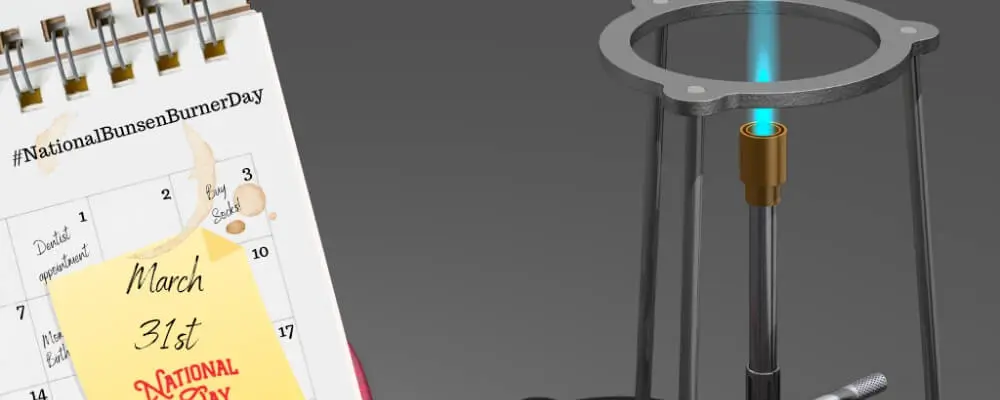The Bunsen burner, an iconic instrument in scientific laboratories worldwide, has been instrumental in numerous groundbreaking experiments and discoveries. However, ensuring safety is paramount with its open flame and the potential hazards associated with its use. Whether you’re a seasoned scientist or a high school student navigating your first laboratory experience, understanding the proper safety protocols around this equipment is crucial.
In this blog, we’ll outline 11 indispensable Bunsen burner safety tips that everyone—from beginners to experts—should be well-versed in. Join us as we turn up the heat on safety standards and ensure every experiment is conducted without a hitch.
Bunsen Burner Safety Tips Everyone Should Know
Bunsen burners are commonplace in laboratories but can pose a risk if used incorrectly. Here are 11 essential Bunsen burner safety tips everyone should be aware of:
1. Wear Proper Lab Attire
When working in a lab, especially around open flames like a Bunsen burner, your attire can play a critical role in your safety. Safety goggles are indispensable because they shield your eyes from potential chemical splashes and the intense brightness of the flame, which could harm your eyesight. A lab coat, made of flame-resistant material, provides a barrier against chemical spills and splatters and protects against potential burns.
Furthermore, long hair can easily fall into the flame or onto hot surfaces, posing a risk of burns or catching fire. Similarly, loose clothing can dangle into flames or chemicals. You minimize the risk of accidents by tying back hair and ensuring clothes are snug or tucked in.
2. Check for Gas Leaks
Before igniting a Bunsen burner, ensuring no gas leaks is vital. A gas leak can lead to unintended fires or even explosions if the escaping gas encounters a spark or flame. Additionally, prolonged inhalation of some gases can be harmful. You can check for leaks by observing any unusual hissing sounds that might indicate escaping gas.
Also, our sense of smell can detect gas leaks, as many laboratory gases have distinct odors. If you suspect a leak, refrain from using the burner until the issue is rectified.
3. Lighting the Burner
When it comes to lighting a Bunsen burner, the method you use can greatly impact your safety. A long-necked lighter or a matchstick offers a safer distance between your hand and the flame, reducing the risk of burns. It’s essential to approach the task cautiously, ensuring the gas is turned on slightly to prevent a large, sudden flame that could cause injuries.

4. Never Leave It Unattended
Open flames in a lab setting, like those from a Bunsen burner, are one of the primary sources of potential accidents. An unattended burner can cause unintended fires if a flammable material comes into contact with the flame.
Furthermore, a sudden surge in gas flow or other equipment malfunctions could result in bigger, uncontrollable fires. Always ensure someone is in the laboratory when a Bunsen burner is on to monitor the situation and act quickly if something goes wrong.
5. Use Tongs or Heat-Resistant Gloves
The objects and glassware near a Bunsen burner can become incredibly hot in a laboratory. Handling these directly with bare hands can result in severe burns. Tongs are useful tools for grabbing or moving hot items without coming into direct contact.
On the other hand, heat-resistant gloves provide a protective barrier for your hands, allowing you to handle hot items safely. It’s crucial always to assess the temperature of an object before attempting to handle it, even with protection, to ensure your safety.
6. Adjust the Flame Properly
Understanding the mechanics of a Bunsen burner is crucial for safety and achieving accurate experimental results. The air hole, often found at the base of the burner, regulates the amount of oxygen that mixes with the gas, which in turn affects the flame’s temperature and color. A blue flame, characterized by its shorter and more intense appearance, indicates complete combustion and is hotter and cleaner.
In contrast, a yellow or orange flame, which is longer and more luminous, is cooler and indicates incomplete combustion. This distinction is important as certain experiments require specific temperatures, and using the wrong flame can alter results or present safety risks.
7. Be Cautious with Flammable Materials
The proximity of flammable materials to an open flame can be a recipe for disaster. Even brief contact between items like paper, certain chemicals, or cloth with a flame can result in a fire that quickly gets out of hand.
Beyond the immediate vicinity of the burner, one must also be wary of the heat radiated, which can ignite flammable materials even from a distance. Therefore, maintaining a clean and organized workspace where only necessary items are present reduces potential fire hazards.
8. Turn Off When Not in Use
A Bunsen burner left on, even momentarily, can pose various risks. For instance, someone might inadvertently place a flammable object nearby or be unaware of the burner’s operation and accidentally knock it over.
Turning off the Bunsen burner when it’s not directly in use can significantly decrease the likelihood of accidents or unintended fires, even if you anticipate using it again shortly.
9. Have Fire Safety Equipment Nearby
Preparation is a cornerstone of safety in any laboratory setting. In an unforeseen incident, having fire safety equipment within arm’s reach can be the difference between a minor accident and a major disaster.
A working fire extinguisher can rapidly control and eliminate small fires. A fire blanket is invaluable for smothering flames, especially on clothing or workbench. An eyewash station is also essential as chemical splashes can occur unexpectedly, and immediate washing can prevent severe eye injuries.

10. Ensure Proper Ventilation
A well-ventilated laboratory ensures that any gases or fumes produced during experiments are efficiently dispelled, reducing the risk of inhalation or the buildup of combustible or toxic atmospheres.
Efficient ventilation systems, including fume hoods, exhaust fans, and air exchange systems, minimize inhalation risks and improve overall lab conditions by maintaining a constant fresh air flow.
11. Know How to React in Case of Emergency
Despite all precautions, emergencies can happen. Knowing how to react swiftly and correctly is crucial. If a fire breaks out, understanding where the gas shutoff is and how to use a fire blanket or extinguisher can be lifesaving.
In cases where someone’s clothing catches fire, the “stop, drop, and roll” technique is essential: stopping movement prevents fanning the flames, dropping to the ground prevents the flames from reaching the face, and rolling smothers the fire. Regular drills and familiarization with safety procedures ensure everyone can respond appropriately when every second counts.
Conclusion
In the grand tapestry of scientific exploration, the Bunsen burner is a testament to innovation and tradition. But as with all powerful tools, it demands respect and a keen understanding of safety. The 11 safety tips outlined in this article aren’t merely suggestions but are essential guidelines that ensure the well-being of every individual stepping into a laboratory.
As we harness the flame to fuel our curiosity and expand our knowledge, let’s remain steadfast in our commitment to safety. After all, the true mark of a skilled scientist isn’t just the discoveries they make but the meticulous care with which they approach every experiment. Stay informed, stay vigilant, and let the flame of curiosity burn brightly—safely.





